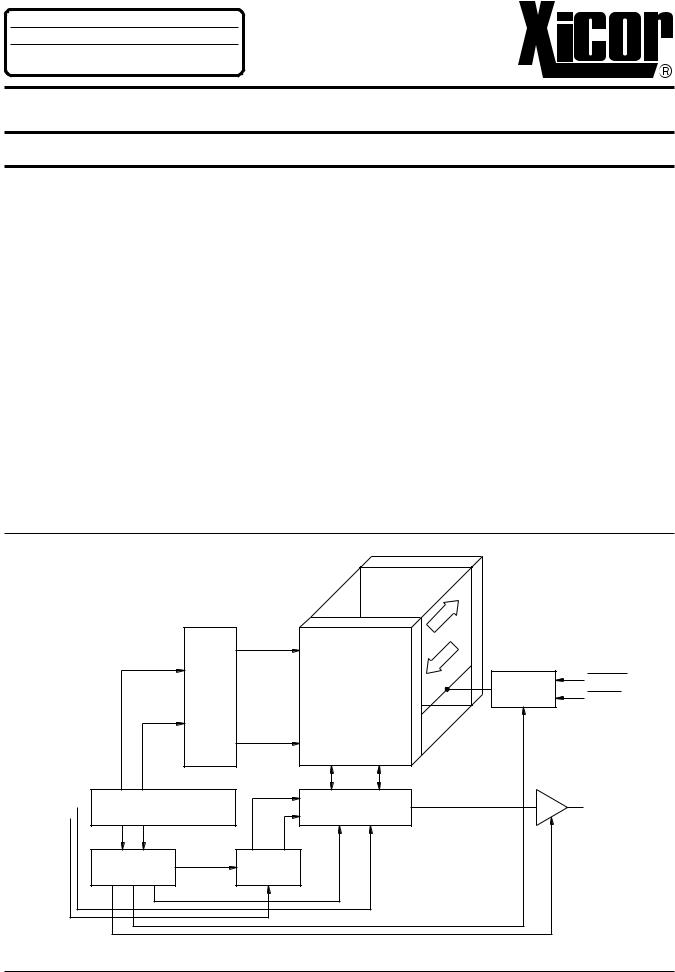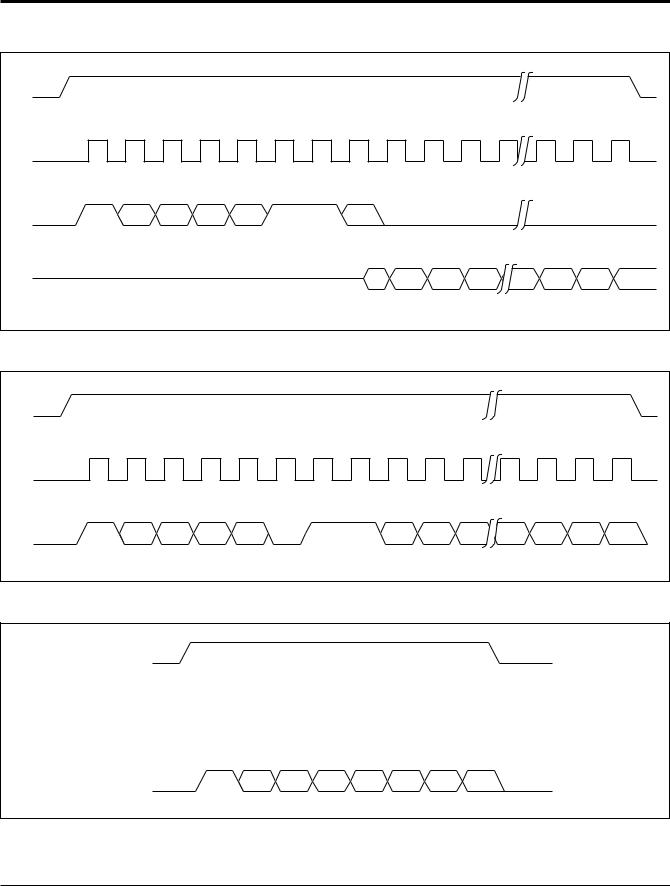XICOR X24C44S, X24C44PM, X24C44PI, X24C44P, X24C44DM Datasheet
...
APPLICATION NOTES
A V A I L A B L E
AN3 • AN7 • AN8 • AN15 • AN16 • AN25 • AN29
• AN30 • AN35 • AN36 • AN39 • AN56 • AN69
X24C44
256 Bit |
X24C44 |
16 x 16 Bit |
Serial Nonvolatile Static RAM
FEATURES
•Advanced CMOS Version of Xicor’s X2444
•16 x 16 Organization
•Single 5 Volt Supply
•Ideal for use with Single Chip Microcomputers —Static Timing
—Minimum I/O Interface
—Serial Port Compatible (COPS™, 8051) —Easily Interfaced to Microcontroller Ports
•Software and Hardware Control of Nonvolatile Functions
•Auto Recall on Power-Up
•TTL and CMOS Compatible
•Low Power Dissipation
—Active Current: 10mA Maximum —Standby Current: 50 μA Maximum
•8-Lead PDIP, Cerdip, and 8-Lead SOIC Packages
•High Reliability
—Store Cycles: 1,000,000 —Data Retention: 100 Years
DESCRIPTION
The Xicor X24C44 is a serial 256 bit NOVRAM featuring a static RAM configured 16 x 16, overlaid bit-by-bit with a nonvolatile E2PROM array. The X24C44 is fabricated with Xicor’s Advanced CMOS Floating Gate technology.
The Xicor NOVRAM design allows data to be transferred between the two memory arrays by means of software commands or external hardware inputs. A store operation (RAM data to E2PROM) is completed in 5ms or less and a recall operation (E2PROM data to RAM) is completed in 2μs or less.
Xicor NOVRAMs are designed for unlimited write operations to RAM, either from the host or recalls from E2PROM and a minimum 1,000,000 store operations. Inherent data retention is specified to be greater than 100 years.
FUNCTIONAL DIAGRAM
CE (1)  DI (3)
DI (3)  SK (2)
SK (2) 
|
NONVOLATILE |
|
||
|
|
E2PROM |
|
|
|
|
STORE |
|
|
|
STATIC |
RECALL |
CONTROL |
|
ROW |
RAM |
|||
LOGIC |
||||
|
||||
DECODE |
256-BIT |
|
||
|
|
|||
INSTRUCTION |
COLUMN |
|
|
|
REGISTER |
DECODE |
|
|
|
INSTRUCTION |
4-BIT |
|
|
|
DECODE |
COUNTER |
|
|
|
RECALL (6)
STORE (7)
DO (4)
3832 FHD F01
COPS is a trademark of National Semiconductor Corp.
© Xicor, Inc. 1991, 1995, 1996 Patents Pending |
1 |
Characteristics subject to change without notice |
3832-1.5 6/19/96 T2/C1/D1 NS |
|
|
|
|

X24C44
PIN DESCRIPTIONS
Chip Enable (CE)
The Chip Enable input must be HIGH to enable all read/ write operations. CE must remain HIGH following a Read or Write command until the data transfer is complete. CE LOW places the X24C44 in the low power standby mode and resets the instruction register. Therefore, CE must be brought LOW after the completion of an operation in order to reset the instruction register in preparation for the next command.
Serial Clock (SK)
The Serial Clock input is used to clock all data into and out of the device.
Data In (DI)
Data In is the serial data input.
Data Out (DO)
Data Out is the serial data output. It is in the high impedance state except during data output cycles in response to a READ instruction.
STORE
STORE LOW will initiate an internal transfer of data from RAM to the E2PROM array.
RECALL
RECALL LOW will initiate an internal transfer of data from E2PROM to the RAM array.
PIN CONFIGURATION
|
PDIP/CERDIP/SOIC |
|
|
|
|||
CE |
|
1 |
8 |
|
VCC |
||
|
|
||||||
|
|
||||||
SK |
|
2 |
7 |
|
|
|
|
|
|
STORE |
|||||
|
|
|
X24C44 |
|
|
|
|
DI |
|
3 |
6 |
|
RECALL |
||
DO |
|
4 |
5 |
|
VSS |
||
|
|
||||||
|
|
||||||
3832 FHD F02.2
PIN NAMES
Symbol |
Description |
|
|
CE |
Chip Enable |
|
|
SK |
Serial Clock |
|
|
DI |
Serial Data In |
DO |
Serial Data Out |
|
|
RECALL |
Recall Input |
|
|
STORE |
Store Input |
VCC |
+5V |
VSS |
Ground |
3832 PGM T01
2

X24C44
DEVICE OPERATION
The X24C44 contains an 8-bit instruction register. It is accessed via the DI input, with data being clocked in on the rising edge of SK. CE must be HIGH during the entire data transfer operation.
Table 1. contains a list of the instructions and their operation codes. The most significant bit (MSB) of all instructions is a logic one (HIGH), bits 6 through 3 are either RAM address bits (A) or don’t cares (X) and bits 2 through 0 are the operation codes. The X24C44 requires the instruction to be shifted in with the MSB first.
After CE is HIGH, the X24C44 will not begin to interpret the data stream until a logic “1” has been shifted in on DI. Therefore, CE may be brought HIGH with SK running and DI LOW. DI must then go HIGH to indicate the start condition of an instruction before the X24C44 will begin any action.
In addition, the SK clock is totally static. The user can completely stop the clock and data shifting will be stopped. Restarting the clock will resume shifting of data.
RCL and RECALL
Either a software RCL instruction or a LOW on the RECALL input will initiate a transfer of E2PROM data
into RAM. This software or hardware recall operation sets an internal “previous recall” latch. This latch is reset upon power-up and must be intentionally set by the user to enable any write or store operations. Although a recall operation is performed upon power-up, the previous recall latch is not set by this operation.
WRDS and WREN
Internally the X24C44 contains a “write enable” latch. This latch must be set for either writes to the RAM or store
Table 1. Instruction Set
operations to the E2PROM. The WREN instruction sets the latch and the WRDS instruction resets the latch, disabling both RAM writes and E2PROM stores, effectively protecting the nonvolatile data from corruption. The write enable latch is automatically reset on power-up.
STO and STORE
Either the software STO instruction or a LOW on the STORE input will initiate a transfer of data from RAM to
E2PROM. In order to safeguard against unwanted store operations, the following conditions must be true:
•STO instruction issued or STORE input is LOW.
•The internal “write enable” latch must be set (WREN instruction issued).
•The “previous recall” latch must be set (either a software or hardware recall operation).
Once the store cycle is initiated, all other device functions are inhibited. Upon completion of the store cycle, the write enable latch is reset. Refer to Figure 4 for a state diagram description of enabling/disabling conditions for store operations.
WRITE
The WRITE instruction contains the 4-bit address of the word to be written. The write instruction is immediately followed by the 16-bit word to be written. CE must remain HIGH during the entire operation. CE must go LOW before the next rising edge of SK. If CE is brought LOW prematurely (after the instruction but before 16 bits of data are transferred), the instruction register will be reset and the data that was shifted-in will be written to RAM.
If CE is kept HIGH for more than 24 SK clock cycles (8-bit instruction plus 16-bit data), the data already shifted-in will be overwritten.
Instruction |
Format, I2 I1 I0 |
Operation |
WRDS (Figure 3) |
1XXXX000 |
Reset Write Enable Latch (Disables Writes and Stores) |
|
|
|
STO (Figure 3) |
1XXXX001 |
Store RAM Data in E2PROM |
Reserved |
1XXXX010 |
N/A |
WRITE (Figure 2) |
1AAAA011 |
Write Data into RAM Address AAAA |
|
|
|
WREN (Figure 3) |
1XXXX100 |
Set Write Enable Latch (Enables Writes and Stores) |
|
|
|
RCL (Figure 3) |
1XXXX101 |
Recall E2PROM Data into RAM |
READ (Figure 1) |
1AAAA11X |
Read Data from RAM Address AAAA |
|
|
|
3832 PGM T13
X = Don't Care
A = Address
3

X24C44
READ
The READ instruction contains the 4-bit address of the word to be accessed. Unlike the other six instructions, I0 of the instruction word is a “don’t care”. This provides two advantages. In a design that ties both DI and DO together, the absence of an eighth bit in the instruction allows the host time to convert an I/O line from an output to an input. Secondly, it allows for valid data output during the ninth SK clock cycle.
D0, the first bit output during a read operation, is truncated. That is, it is internally clocked by the falling edge of the eighth SK clock; whereas, all succeeding bits are clocked by the rising edge of SK (refer to Read Cycle Diagram).
LOW POWER MODE
When CE is LOW, non-critical internal devices are powered-down, placing the device in the standby power mode, thereby minimizing power consumption.
SLEEP
Because the X24C44 is a low power CMOS device, the SLEEP instruction implemented on the first generation NMOS device has been deleted. For systems converting from the X2444 to the X24C44 the software need not be changed; the instruction will be ignored.
WRITE PROTECTION
The X24C44 provides two software write protection mechanisms to prevent inadvertent stores of unknown data.
Power-Up Condition
Upon power-up the “write enable” latch is in the reset state, disabling any store operation.
Unknown Data Store
The “previous recall” latch must be set after power-up. It may be set only by performing a software or hardware recall operation, which assures that data in all RAM locations is valid.
SYSTEM CONSIDERATIONS
Power-Up Recall
The X24C44 performs a power-up recall that transfers the E2PROM contents to the RAM array. Although the data may be read from the RAM array, this recall does not set the “previous recall” latch. During this power-up recall operation, all commands are ignored. Therefore, the host should delay any operations with the X24C44 a minimum of tPUR after VCC is stable.
Power-Down Data Protection
Because the X24C44 is a 5V only nonvolatile memory device it may be susceptible to inadvertent stores to the E2PROM array during power-down cycles. Power-up cycles are not a problem because the “previous recall” latch and “write enable” latch are reset, preventing any possible corruption of E2PROM data.
Software Power-Down Protection
If the STORE and RECALL pins are tied to VCC through a pull-up resistor and only software operations are performed to initiate stores, there is little likelihood of an inadvertent store. However, if these two lines are under microprocessor control, positive action should be employed to negate the possibility of these control lines bouncing and generating an unwanted store. The safest method is to issue the WRDS command after a write sequence and also following store operations. Note: an internal store may take up to 5ms; therefore, the host microprocessor should delay 5ms after initiating the store prior to issuing the WRDS command.
Hardware Power-Down Protection
(when the “write enable” latch and “previous recall” latch are not in the reset state):
Holding either RECALL LOW, CE LOW or STORE HIGH during power-down will prevent an inadvertent store.
4

X24C44
Figure 1. RAM Read
CE |
|
|
|
|
|
|
|
|
|
|
|
|
|
|
|
SK |
1 |
2 |
3 |
4 |
5 |
6 |
7 |
8 |
9 |
10 |
11 |
12 |
22 |
23 |
24 |
DI |
1 |
A |
A |
A |
A |
1 |
1 |
X* |
|
|
|
|
|
|
|
DO |
|
|
|
HIGH Z |
|
|
|
D0 |
D1 |
D2 |
D3 |
D13 |
D14 |
D15 |
D0 |
|
|
|
|
|
|
|
|||||||||
|
|
*Bit 8 of Read Instructions is Don’t Care |
|
|
|
|
|
|
|
3832 FHD F07.1 |
|||||
|
|
|
|
|
|
|
|
|
|
|
|
|
|
||
Figure 2. RAM Write
CE |
|
|
|
|
|
|
|
|
|
|
|
|
|
|
|
SK |
1 |
2 |
3 |
4 |
5 |
6 |
7 |
8 |
9 |
10 |
11 |
21 |
22 |
23 |
24 |
DI |
1 |
A |
A |
A |
A |
0 |
1 |
1 |
D0 |
D1 |
D2 |
D12 |
D13 |
D14 |
D15 |
|
|
|
|
|
|
|
|
|
|
|
|
|
|
|
3832 FHD F08.1 |
Figure 3. Non-Data Operations
CE
SK |
|
1 |
|
2 |
|
3 |
|
4 |
|
5 |
|
6 |
|
7 |
|
8 |
|
|
|
|
|
|
|
|
|
|
|
|
|
|
|
|
|
|
|
|
|
|
|
DI |
1 |
X |
X |
X |
X |
I2 |
I1 |
I0 |
3832 FHD F09.1
5
